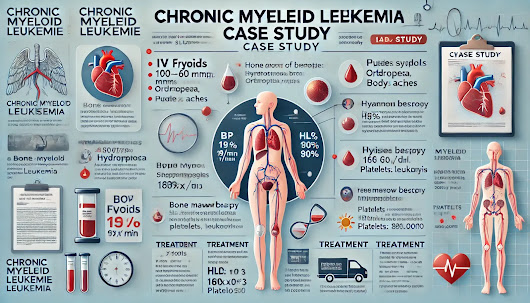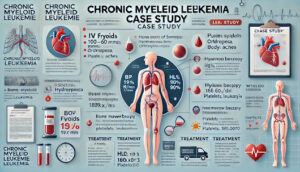Introduction
Chronic Myeloid Leukemia (CML) is a myeloproliferative neoplasm characterized by uncontrolled proliferation of myeloid cells in the bone marrow. It is often associated with the Philadelphia chromosome (Ph+), resulting in the formation of the BCR-ABL fusion gene that drives leukemogenesis. Although CML primarily affects middle-aged and older adults, its presentation can vary significantly, influencing both diagnosis and treatment strategies.
In this case report, we discuss a 50-year-old female patient diagnosed with CML and highlight the diagnostic approach, management plan, and prognosis associated with this hematological malignancy.
Case Presentation
Clinical History and Symptoms
The patient, a 50-year-old female , presented with a one-month history of fever, exertional dyspnea, orthopnea, and generalized body aches with back pain. The combination of these symptoms raised concerns regarding hematological, infectious, and systemic disorders, warranting further clinical evaluation.
Initial Clinical Examination and Vital Signs
On presentation, the patient exhibited:
- Blood Pressure: 100/60 mmHg 📉
- Pulse Rate: 98/min ❤️
- SpO₂: 80% on room air, indicating hypoxia ⚠️
- Random Blood Sugar (RBS): 121 mg/dL
A physical examination revealed tachypnea, pallor, hepatosplenomegaly, and abnormal respiratory findings (bilateral wheezing and crepitations), suggestive of both hematological and respiratory involvement.
Laboratory Investigations
A series of diagnostic tests were performed to identify the underlying pathology:
-
Complete Blood Count (CBC):
- Total Leukocyte Count (TLC): 160 × 10⁹/L (elevated)
- Hemoglobin (Hb): 11 g/dL (mild anemia)
- Platelets: 80,000 (mild thrombocytopenia)
-
Differential Leukocyte Count (DLC):
- Neutrophils: 75%
- Lymphocytes: 5%
- Eosinophils: 3%
- Myelocytes: 15% (indicative of myeloproliferation)
-
Peripheral Smear Findings:
- Neutrophilic leukocytosis with a left shift
- Elevated myelocytes (15%)
-
Inflammatory Markers & Biochemical Investigations:
- CRP: 33 mg/L (elevated, indicating systemic inflammation)
- Electrolytes:
- Sodium: 138 mmol/L
- Potassium: 3.07 mmol/L (hypokalemia)
-
Hepatitis Screening: Negative ✅
-
Urinalysis (Urine RE): WBCs 10–20, RBCs nil
-
Liver Function Tests (LFTs): Normal
-
Ultrasound Abdomen:
- Mild splenomegaly and hepatomegaly (common in myeloproliferative disorders)
Definitive Diagnosis: Chronic Myeloid Leukemia (CML)
A bone marrow biopsy confirmed the presence of 15% myelocytes, a hallmark feature of CML in the chronic phase. Further cytogenetic and molecular studies (BCR-ABL via FISH) were negative, and Philadelphia chromosome results were pending.
Management and Treatment Approach
Upon confirmation of CML (chronic phase), the patient was started on targeted therapy and supportive care:
-
Initial Supportive Management:
- IV fluids for hydration 💧
- IV painkillers for symptomatic relief 💊
- Proton Pump Inhibitors (PPIs) for gastric protection
-
Pharmacological Therapy:
- Hydroxyurea (to reduce leukocytosis)
- Allopurinol (to prevent tumor lysis syndrome)
- Imatinib (100 mg, 4 tablets OD) – a first-line tyrosine kinase inhibitor (TKI) used for BCR-ABL-positive CML, initiated after oncology consultation.
- Inj. Tanzo & Inj. Grasil (likely used for supportive care and infection prevention)
Follow-up and Prognosis
- The patient’s CRP levels improved, indicating reduced systemic inflammation.
- Symptomatic relief was achieved with targeted therapy.
- The patient remains under continuous treatment and monitoring, with further follow-up required for Philadelphia chromosome status and treatment response evaluation.
Discussion and Clinical Significance
CML is a clonal hematopoietic stem cell disorder that progresses through three distinct phases: chronic, accelerated, and blast crisis. Early detection in the chronic phase, as seen in this case, offers the best prognosis with tyrosine kinase inhibitor (TKI) therapy.
Key Learning Points:
✅ Multisystem involvement in CML can present with respiratory distress, hepatosplenomegaly, and systemic inflammation.
✅ Bone marrow biopsy and cytogenetic studies are crucial for confirming CML and differentiating it from other myeloproliferative neoplasms.
✅ Tyrosine kinase inhibitors (TKIs) like Imatinib are the gold standard for treating BCR-ABL-positive CML, improving survival rates.
✅ Long-term follow-up is necessary to assess treatment response, monitor side effects, and detect disease progression.



Pingback: Breast Cancer SDG 3